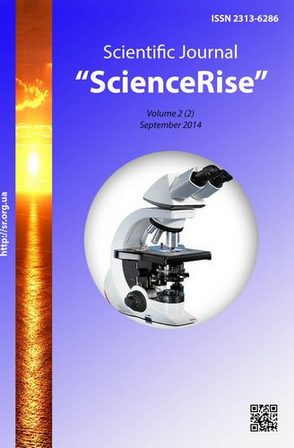Analysis of energy consumption nodes wireless sensor networks
DOI:
https://doi.org/10.15587/2313-8416.2014.27246Keywords:
consumption, router, wireless sensor networks, cycle activity, cycle of lifeAbstract
The article considers the issue of energy consumption and energy efficiency of the nodes of wireless sensor networks (WSN). It is revealed that the main factor influencing the increase in the probability of a malfunction of sensor networks is the limited resources of the power node. The methodology of calculation of energy consumption of nodes and the lifetime of the elements of their power.
References
Terentev, M. N. (2010). The method of operation of systems for monitoring the parameters of objects with configurable based on discrete wireless sensor networks. Dissertation, 154.
Ivanova, I. A (2010). Defining the perimeter coverage of wireless sensor networks. Industrial process control, and controllers, 10, 25–30.
Measuring Power Consumption of CC2530 With Z-Stack (2012). Texas Instruments Application Ноте AN079, 1–18. Available at: http://www.ti.com/lit/an/swra292/swra292.pdf/
Vlasova, V. A., Zelenin, A. N. (2012). Analysis of the energy cycle nodes of wireless sensor networks. Eastern-European Journal of Enterprise Technologies, 3 (9), 13–17.
Second Generation System-on-Chip Solution for 2.4 GHz IEEE 802.15.4 / RF4CE / ZigBee (2014). Texas Instruments, 1–34. Available at: http://www.ti.com/lit/ds/symlink/cc2530.pdf/
IEEE Standard for Information Technology – Telecommunications and Information Exchange Between Systems – Local and Metropolitan Area Networks –Specific Requirements – Part 15.4: Wireless Medium Access Control (MAC) and Physical Layer (PHY) Specifications for Low-Rate Wireless Personal Area Networks (2009). IEEE Std. 802.15.4-2009, 1–39. Available at: http://standards.ieee.org/getieee802/download/802.15.4d-2009.pdf/
Galkin, P. V., Karlovsky, D. V. (2010). Features of realization of off-wire sensory networks on the basis of technology of ZigBee. VII Międzynarodowej naukowi-praktycznej konferencji «Nauka i inowacja-2011», 31, 7–11.
Chen, Y., Nasser, N. (2006). Energy-balancing multipath routing protocol for wireless sensor networks. Proceedings of the 3rd international conference on Quality of service in heterogeneous wired/wireless networks QShine’06, 14, 245–249. doi: 10.1145/1185373.1185401.
Baskakov, C. (2010). Evaluation of the energy consumption of wireless nodes in the network MeshLogic. Wireless technologies, 1, 28–31.
Intellecutally wireless sensor networks MeshLogic (2014). MeshLogic Available at : http://www.meshlogic.ru
Olifer V. G., Olifer N. A. (2010) Principles, technologies and protocols. Piter, 4, 943.
Kireyev, A. O., Svetlov A. C (2011). Distributed system for energy monitoring of wireless sensor networks. News SFU. Technical science, 5, 60–65
Taganova, A. A., Bubnov, S. I.,. Orlov, S. B. (2005). Sealed chemical current sources: Elements and batteries. The equipment for testing and operation, 264.
Kramarenko, E. G., Privalov, M. V. (2013). Reduction of energy consumption in sensor networks for the expense of pre-compression data. Information control systems and computer monitoring of 2013. The collection of materials of the IV all-Ukrainian scientific-technical conference of students, postgraduates and young scientists, 364–369.
Galkin, P. V., Borisenko, A. S. (2013). Adequacy of model wireless sensor networks in imitation simulation tools. Eastern-European Journal of Enterprise Technologies, 4 (9), 52–55.
Galkin, P. V., Golovkina, L. V., Borisenko, A. S. (2011). Investigation of the influence of forests on the range of communication networks ZigBee. East European Journal of Enterprise Technologies, 3 (2), 4–9.
Pushkarev, O. (2011). The use of end-sleeping nodes in a ZigBee network. Electronic components, 5, 91–95.
Downloads
Published
Issue
Section
License
Copyright (c) 2014 Павел Викторович Галкин

This work is licensed under a Creative Commons Attribution 4.0 International License.
Our journal abides by the Creative Commons CC BY copyright rights and permissions for open access journals.
Authors, who are published in this journal, agree to the following conditions:
1. The authors reserve the right to authorship of the work and pass the first publication right of this work to the journal under the terms of a Creative Commons CC BY, which allows others to freely distribute the published research with the obligatory reference to the authors of the original work and the first publication of the work in this journal.
2. The authors have the right to conclude separate supplement agreements that relate to non-exclusive work distribution in the form in which it has been published by the journal (for example, to upload the work to the online storage of the journal or publish it as part of a monograph), provided that the reference to the first publication of the work in this journal is included.

